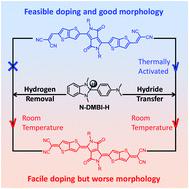当前位置:
X-MOL 学术
›
J. Mater. Chem. A
›
论文详情
Our official English website, www.x-mol.net, welcomes your feedback! (Note: you will need to create a separate account there.)
Doping mechanisms of N-DMBI-H for organic thermoelectrics: hydrogen removal vs. hydride transfer
Journal of Materials Chemistry A ( IF 11.9 ) Pub Date : 2020-04-01 , DOI: 10.1039/d0ta01087a Yan Zeng 1, 2, 3, 4, 5 , Wenyu Zheng 1, 2, 3, 4, 5 , Yuan Guo 1, 2, 3, 4, 5 , Guangchao Han 1, 2, 3, 4, 5 , Yuanping Yi 1, 2, 3, 4, 5
Journal of Materials Chemistry A ( IF 11.9 ) Pub Date : 2020-04-01 , DOI: 10.1039/d0ta01087a Yan Zeng 1, 2, 3, 4, 5 , Wenyu Zheng 1, 2, 3, 4, 5 , Yuan Guo 1, 2, 3, 4, 5 , Guangchao Han 1, 2, 3, 4, 5 , Yuanping Yi 1, 2, 3, 4, 5
Affiliation

|
Efficient n-doping is a big challenge to organic thermoelectrics due to the requirements of both low ionization potentials and good air-stability. In recent years, N-DMBI-H has been reported as the most successful solution-processed n-type dopant precursor, but the doping mechanisms have been unclear to date. Here, we have investigated both hydrogen removal and hydride transfer reactions of N-DMBI-H doped in representative n-type molecular semiconductors (i.e., aromatic A-DCV-DPPTT and quinoid Q-DCM-DPPTT) by means of density functional theory calculations. The results demonstrate that N-DMBI-H is an air-stable n-type dopant precursor. Interestingly, when the N-DMBI-H precursor is associated with the semiconductor molecules, the reaction energy barriers for both hydrogen removal and hydride transfer are substantially decreased because of the assistance from the strong electron affinity of the semiconductors. In the case of the A-DCV-DPPTT/N-DMBI-H complexes, the hydride transfer reaction can be thermally activated. Notably, for the Q-DCM-DPPTT/N-DMBI-H complexes, both the chemical reactions can take place and bring about efficient charge transfer at room temperature. However, owing to the strong binding between the dopant and semiconductor molecules in the charge–transfer complexes, long-range ordered molecular packing will be disrupted for Q-DCM-DPPTT during solution processing, which is detrimental to charge transport; thus the experimental electrical conductivity is relatively lower for Q-DCM-DPPTT with respect to A-DCV-DPPTT. This work provides an in-depth understanding of the n-doping mechanisms of N-DMBI-H, paving the way towards rational development of both molecular dopants and semiconductors for high-performance organic thermoelectrics.
中文翻译:

N-DMBI-H用于有机热电的掺杂机理:除氢与氢化物转移
由于对低电离电势和良好的空气稳定性的要求,有效的n掺杂是有机热电技术的一大挑战。近年来,已报道N-DMBI-H是最成功的溶液处理n型掺杂剂前体,但是迄今为止,掺杂机理尚不清楚。在这里,我们研究了在代表性的n型分子半导体中掺杂的N-DMBI-H的除氢和氢化物转移反应(即,芳香族A-DCV-DPPTT和醌型Q-DCM-DPPTT)通过密度泛函理论计算。结果表明,N-DMBI-H是空气稳定的n型掺杂剂前体。有趣的是,当N-DMBI-H前体与半导体分子结合时,由于半导体的强电子亲和力的辅助,用于除氢和氢化物转移的反应能垒大大降低了。在A-DCV-DPPTT / N-DMBI-H配合物的情况下,氢化物转移反应可以被热活化。值得注意的是,对于Q-DCM-DPPTT / N-DMBI-H配合物,两种化学反应均可发生,并在室温下实现有效的电荷转移。但是,由于电荷转移复合物中掺杂剂和半导体分子之间的牢固结合,Q-DCM-DPPTT在溶液处理过程中的长程有序分子堆积将被破坏,这对电荷传输是有害的;因此,相对于A-DCV-DPPTT,Q-DCM-DPPTT的实验电导率相对较低。这项工作提供了对N-DMBI-H的n掺杂机制的深入理解,为合理开发高性能有机热电分子的分子掺杂剂和半导体铺平了道路。
更新日期:2020-04-24
中文翻译:

N-DMBI-H用于有机热电的掺杂机理:除氢与氢化物转移
由于对低电离电势和良好的空气稳定性的要求,有效的n掺杂是有机热电技术的一大挑战。近年来,已报道N-DMBI-H是最成功的溶液处理n型掺杂剂前体,但是迄今为止,掺杂机理尚不清楚。在这里,我们研究了在代表性的n型分子半导体中掺杂的N-DMBI-H的除氢和氢化物转移反应(即,芳香族A-DCV-DPPTT和醌型Q-DCM-DPPTT)通过密度泛函理论计算。结果表明,N-DMBI-H是空气稳定的n型掺杂剂前体。有趣的是,当N-DMBI-H前体与半导体分子结合时,由于半导体的强电子亲和力的辅助,用于除氢和氢化物转移的反应能垒大大降低了。在A-DCV-DPPTT / N-DMBI-H配合物的情况下,氢化物转移反应可以被热活化。值得注意的是,对于Q-DCM-DPPTT / N-DMBI-H配合物,两种化学反应均可发生,并在室温下实现有效的电荷转移。但是,由于电荷转移复合物中掺杂剂和半导体分子之间的牢固结合,Q-DCM-DPPTT在溶液处理过程中的长程有序分子堆积将被破坏,这对电荷传输是有害的;因此,相对于A-DCV-DPPTT,Q-DCM-DPPTT的实验电导率相对较低。这项工作提供了对N-DMBI-H的n掺杂机制的深入理解,为合理开发高性能有机热电分子的分子掺杂剂和半导体铺平了道路。



























 京公网安备 11010802027423号
京公网安备 11010802027423号